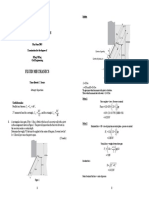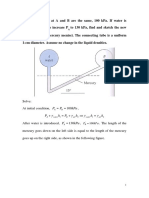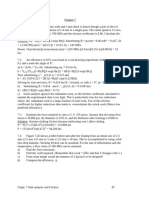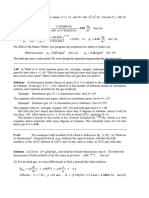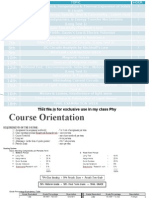Chapter 2
Uploaded by
Zadky RiosChapter 2
Uploaded by
Zadky Rios2.41 The system in Fig. P2.41 is at 20C.
Determine the pressure at point A in pounds per
square foot.
Solution: Take the specific weights of water and mercury from Table 2.1. Write the
hydrostatic formula from point A to the water surface:
3
A atm
2
6 10 5 lbf
p (0.85)(62.4 lbf/ft ) ft (846) (62.4) p (14.7)(144)
12 12 12 ft
| | | | | |
+ + = =
| | |
\ . \ . \ .
A
Solve for p . =
2
2770 lbf/ft Ans
Fig. P2.41
2.64 Gate ABC in Fig. P2.64 has a fixed hinge at B and is 2 m wide into the paper. If the water
level is high enough, the gate will open. Compute the depth h for which this happens.
Solution: Let H = (h 1 meter) be the depth down to the level AB. The forces on AB and BC
are shown in the freebody at right. The moments of these forces about B are equal when the gate
opens:
B
M 0 H(0.2)b(0.1)
H H
(Hb)
2 3
= =
| | | |
=
| |
\ . \ .
or: H 0.346 m,
h H 1 . Ans
=
= + = 1.346 m
This solution is independent of both the water density and the gate width b into the paper.
Fig. P2.64
2.87 The bottle of champagne (SG = 0.96) in Fig. P2.87 is under pressure as shown by the
mercury manometer reading. Compute the net force on the 2-in-radius hemispherical end cap at
the bottom of the bottle.
Solution: First, fromthe manometer, com-pute the gage pressure at section AA in the champagne 6 inches
above the bottom:
AA atmosphere
2 4
p (0.96 62.4) ft (13.56 62.4) ft p 0(gage),
12 12
| | | |
+ = =
| |
\ . \ .
2
AA
or: P 272 lbf/ft (gage) =
Then the force on the bottom end cap is vertical only (due to symmetry) and equals the force at
section AA plus the weight of the champagne below AA:
V AA AA 6-in cylinder 2-in hemisphere
2 2 3
F F p (Area) W W
(272) (4/12) (0.96 62.4) (2/12) (6/12) (0.96 62.4)(2 /3)(2/12)
4
23.74 2.61 0.58 . Ans
t
t t
= = +
= +
= + ~ 25.8 lbf
Fig. P2.87
2.114 The uniform rod in the figure is hinged at B and in static equilibrium when 2 kg of lead
(SG = 11.4) are attached at its end. What is the specific gravity of the rod material? What is
peculiar about the rest angle u = 30?
Solution: First compute buoyancies: Brod = 9790(t/4)(0.04)
2
(8) = 98.42 N, and Wlead =
2(9.81) = 19.62 N, Blead = 19.62/11.4 = 1.72 N. Sum moments about B:
0 ( 1)(98.42)(4cos30 ) (19.62 1.72)(8cos30 ) 0
B
M SG = = + =
Solve for . (a) Ans
rod
SG 0.636 =
The angle u drops out! The rod is neutrally stable for any tilt angle! Ans. (b)
2.129 The iceberg of Prob. 2.128 may become unstable if its width decreases. Suppose that the
height is L and the depth into the paper is L but the width decreases to H < L. Again with S =
0.88 for the iceberg, determine the ratio H/L for which the iceberg becomes unstable.
Solution: As in Prob. 2.128, the submerged distance h = SL = 0.88L, with G at L/2 above the
bottom and B at h/2 above the bottom. From Eq. (2.52), the distance MB is
3 2
o
sub
I LH /12 H L SL
MB MG GB MG
HL(SL) 12SL 2 2 u
| |
= = = = + = +
|
\ .
Then neutral stability occurs when MG = 0, or
2
1/2 1/2
H L H
(1 S), or [6S(1 S)] [6(0.88)(1 0.88)] .
12SL 2 L
Ans = = = = 0.796
2.143 The tank of water in Fig. P2.143 is full and open to the atmosphere (patm =
15 psi = 2160 psf) at point A, as shown. For what acceleration ax, in ft/s
2
, will the pressure at
point B in the figure be
(a) atmospheric; and (b) zero absolute (neglecting cavitation)?
Solution: (a) For pA = pB, the imaginary free surface isobar should join points A and B:
45 1.0 / , hence . (a)
AB x x
a g a g Ans u = = = = =
2
tan tan 32.2 ft/s
(b) For pB = 0, the free-surface isobar must tilt even more than 45, so that
0 2160 1.94(32.2)(2) 1.94 (2),
B A x x
p p g z a x a = = + A A = +
. (b)
x
solve a Ans =
2
589 ft/s
This is a very high acceleration (18 gs) and a very steep angle, u = tan
1
(589/32.2) = 87.
Fig. P2.143
P2.153Acylindricalcontainer,14inchesindiameter,isusedtomakeamoldforforming
saladbowls.Thebowlsaretobe8inchesdeep.Thecylinderishalffilledwithmoltenplastic,
=1.6kg/(ms),rotatedsteadilyaboutthecentralaxis,thencooledwhilerotating.Whatisthe
appropriaterotationrate,inr/min?
Solution: The molten plastic viscosity is a red herring, ignore. The appropriate final rotating
surface shape is a paraboloid of radius 7 inches and depth 8 inches. Thus, from Fig. 2.23,
2 2 2 2
2
(7/12 ) 8
8
12 2
2(32.2 / )
60
Solvefor 11.2 .
2
R ft
h in ft
g
ft s
rad r
Ans
s min t
O O
= = = =
O = = 107
1.83* A two-dimensional unsteady velocity field is given by u = x(1 + 2t), v = y. Find the
time-varying streamlines which pass through some reference point (xo,yo). Sketch some.
Solution: Equation (1.44) applies with time as a parameter:
= = = = +
+ +
dx dx dy dy 1
, or: ln(y) ln(x) constant
u x(1 2t) v y 1 2t
+
=
1/(1 2t)
or: y Cx , where C is a constant
In order for all streamlines to pass through y = yo at x = xo, the constant must be such that:
/ . Ans
1/(1 2t)
o o
( )
+
= y y x x
Some streamlines are plotted on the next page and are seen to be strongly time-varying.
P3.117 Water at 20C, in the pressurized
tank of Fig. P3.117, flows out and creates a
vertical jet as shown. Assuming steady
frictionless flow, determine the height H
to which the jet rises.
85cm
H?
Air
water
Fig.P3.117
(1)
(2)
(3)
Solution: This is a straightforward Bernoulli problem. Let the water surface
be (1), the exit plane be (2), and the top of the vertical jet be (3). Let z
2
=0 for convenience.
If we are clever, we can bypass (2) and write Bernoulli directly from (1) to (3):
If we took an intermediate step from (1) to (2), we would find V
2
2
/2g =8.51 m, and then going from
(2) to (3) would convert the velocity head into pure elevation, because V
3
=0.
P4.74 Consider the two-dimensional incompressible polar-coordinate velocity potential
where B is a constant and L is a constant length scale. (a) What are the dimensions of B?
(b) Locate the only stagnation point in this flow field. (c) Prove that a stream function exists and then
find the function (r, u).
Solution: (a) To give | its correct dimensions of {L
2
/T}, the constant B must have the dimensions of
velocity, or {L/T}. Ans.(a)
(b) Calculate velocities in polar coordinates:
At first it doesnt look as if we can find a stagnation point, but indeed there is one:
As discussed later in Chap. 8, this is the velocity potential of a Rankine half-body.
(c) With the velocities known, check the continuity equation:
. 85 . 0 66 . 7
0 0 85 . 0 _ 0
) 998 )( 81 . 9 (
75000
: o ,
2 2
3
2
3 3
1
2
1 1
Ans m m H Solve
H m
r z
g
V
g
p
z
g
V
g
p
m 8.51 = + =
+ + = +
+ + = + +
u u | L B r B + = cos
1
cos ; sin
r
BL
v B v B
r r r
u
u u
u
c c
= = = = +
c c
, 90 : 0 , 0 .( )
r
r L v v Ans b
u
u = = = =
Continuity is satisfied. Find the stream function from the definition of (r, u):
C2.3 Professor F. Dynamics, riding the merry-go-round with his son, has brought along his U-
tube manometer. (You never know when a manometer might come in handy.) As shown in Fig.
C2.3, the merry-go-round spins at constant angular velocity and the manometer legs are 7 cm apart.
The manometer center is 5.8 m from the axis of rotation. Determine the height difference h in
two ways: (a) approximately, by assuming rigid body translation with a equal to the average
manometer acceleration; and (b) exactly, using rigid-body rotation theory. How good is the
approximation?
Solution: (a) Approximate: The average acceleration of the manometer is RavgO
2
=
5.8[6(2t/60)]
2
= 2.29 rad/s toward the center of rotation, as shown. Then
tan( ) a/g 2.29/9.81 h/(7 cm) 0.233 u = = = =
Solve for . (a) h Ans = 1.63 cm
satisfied Yes, 0
cos cos
0
1
) (
1
= = =
c
c
+
c
c
r
B
r
B v
r
v r
r r
r
u u
u
u
1
cos ; sin
Integrate: sin ln .( )
r
BL
v B v B
r r r
Br B L r const Ans c
u
u u
u
u
c c
= = = = +
c c
= +
(b) Exact: The isobar in the figure at right would be on the parabola z = C + r
2
O
2
/(2g), where C
is a constant. Apply this to the left leg (z1) and right leg (z2). As above, the rotation rate is O =
6.0*(2t/60) = 0.6283 rad/s. Then
O
= = = +
2 2
2 2 2 2
2 1 2 1
(0.6283)
( ) [(5.8 0.035) (5.8 0.035) ]
2 2(9.81)
. (b)
h z z r r
g
Ans = 0.0163 m
This is nearly identical to the approximate answer (a), because R >>Ar.
You might also like
- Fluid Mechanics 7th Edition White Solution Manual50% (22)Fluid Mechanics 7th Edition White Solution Manual116 pages
- Solution Manual Fluid Mechanics 4th Edition Frank M White67% (3)Solution Manual Fluid Mechanics 4th Edition Frank M White17 pages
- Solution-Manual-for-Fluid-Mechanics-8th-Edition-White - CHAPTER 2No ratings yetSolution-Manual-for-Fluid-Mechanics-8th-Edition-White - CHAPTER 23 pages
- Azdoc - Tips White Fluid Mechanics 5e Solutions Fluidmechwhite5ech02part2bNo ratings yetAzdoc - Tips White Fluid Mechanics 5e Solutions Fluidmechwhite5ech02part2b10 pages
- Q1. A solid cylindrical needle of diameter d, length L, and density ρn may "float" on a liquidNo ratings yetQ1. A solid cylindrical needle of diameter d, length L, and density ρn may "float" on a liquid5 pages
- ME:5160 (58:160) Intermediate Mechanics of Fluids Fall 2022 - HW3 SolutionNo ratings yetME:5160 (58:160) Intermediate Mechanics of Fluids Fall 2022 - HW3 Solution7 pages
- Fluid Mechanics White 7th SOL Part1 Part7No ratings yetFluid Mechanics White 7th SOL Part1 Part75 pages
- Hydrology - Tutorial 2 Trapezoidal Channels in This Tutorial You WillNo ratings yetHydrology - Tutorial 2 Trapezoidal Channels in This Tutorial You Will0 pages
- Solution: First Sum Moments Clockwise About The Hinge A of The HandleNo ratings yetSolution: First Sum Moments Clockwise About The Hinge A of The Handle5 pages
- Fluid Mechanics White 7th SOL Part1 Part8No ratings yetFluid Mechanics White 7th SOL Part1 Part85 pages
- Fluid Mechanics White 7th SOL Part1 Part6No ratings yetFluid Mechanics White 7th SOL Part1 Part65 pages
- Solutionmanual7!8!150303094025 Conversion Gate01No ratings yetSolutionmanual7!8!150303094025 Conversion Gate0112 pages
- Solutions To Exercise One - Fluid Statics and Manometers: Mechanical Engineering 390 Fluid MechanicsNo ratings yetSolutions To Exercise One - Fluid Statics and Manometers: Mechanical Engineering 390 Fluid Mechanics5 pages
- PCB3013-Well Test Analysis HW# 8 Prof. Dr. Mustafa Onur, UTP, September 2013No ratings yetPCB3013-Well Test Analysis HW# 8 Prof. Dr. Mustafa Onur, UTP, September 20133 pages
- School of Civil Engineering: DR Matthew Scase H22 HG2No ratings yetSchool of Civil Engineering: DR Matthew Scase H22 HG24 pages
- Fluid Mechanics White 7th SOL Part1 Part5No ratings yetFluid Mechanics White 7th SOL Part1 Part55 pages
- 10+2 Level Mathematics For All Exams GMAT, GRE, CAT, SAT, ACT, IIT JEE, WBJEE, ISI, CMI, RMO, INMO, KVPY Etc.From Everand10+2 Level Mathematics For All Exams GMAT, GRE, CAT, SAT, ACT, IIT JEE, WBJEE, ISI, CMI, RMO, INMO, KVPY Etc.No ratings yet
- Ashashi Ginger IPA - English IPA: FermentablesNo ratings yetAshashi Ginger IPA - English IPA: Fermentables2 pages
- Visual Studio .NET - Guide For DevelopersNo ratings yetVisual Studio .NET - Guide For Developers305 pages
- Product - Info G 2 B Annealing Furnace GLO ENNo ratings yetProduct - Info G 2 B Annealing Furnace GLO EN12 pages
- AA200A Applied Aerodynamics: Chapter 1 - Introduction To Fluid FlowNo ratings yetAA200A Applied Aerodynamics: Chapter 1 - Introduction To Fluid Flow42 pages
- CE 442 Material and Pavement Design: Chapter I: IntroductionNo ratings yetCE 442 Material and Pavement Design: Chapter I: Introduction20 pages
- Chiller Water Carrier AquaForce 30XW (225 300 Ton)No ratings yetChiller Water Carrier AquaForce 30XW (225 300 Ton)4 pages
- Namma Kalvi 12th Chemistry Unit 5 PowerPoint Presentation Material EM 219412No ratings yetNamma Kalvi 12th Chemistry Unit 5 PowerPoint Presentation Material EM 219412111 pages
- Cleaning and Flushing Basics For Hydraulic Systems and Similar MachinesNo ratings yetCleaning and Flushing Basics For Hydraulic Systems and Similar Machines13 pages
- Download Complete Chemical Ionization Mass Spectrometry Second Edition Alex G. Harrison PDF for All Chapters100% (2)Download Complete Chemical Ionization Mass Spectrometry Second Edition Alex G. Harrison PDF for All Chapters62 pages
- Structural Health Monitoring: Mr. Praveen Kumar Yadav Assistant Professor ITS Engineering College100% (1)Structural Health Monitoring: Mr. Praveen Kumar Yadav Assistant Professor ITS Engineering College44 pages
- Solubility and Dissolution Enhancement of Carvedilol by Solid Dispersion Technique Using Gelucire 50/13No ratings yetSolubility and Dissolution Enhancement of Carvedilol by Solid Dispersion Technique Using Gelucire 50/135 pages
- Solution Manual Fluid Mechanics 4th Edition Frank M WhiteSolution Manual Fluid Mechanics 4th Edition Frank M White
- Solution-Manual-for-Fluid-Mechanics-8th-Edition-White - CHAPTER 2Solution-Manual-for-Fluid-Mechanics-8th-Edition-White - CHAPTER 2
- Azdoc - Tips White Fluid Mechanics 5e Solutions Fluidmechwhite5ech02part2bAzdoc - Tips White Fluid Mechanics 5e Solutions Fluidmechwhite5ech02part2b
- Q1. A solid cylindrical needle of diameter d, length L, and density ρn may "float" on a liquidQ1. A solid cylindrical needle of diameter d, length L, and density ρn may "float" on a liquid
- ME:5160 (58:160) Intermediate Mechanics of Fluids Fall 2022 - HW3 SolutionME:5160 (58:160) Intermediate Mechanics of Fluids Fall 2022 - HW3 Solution
- Hydrology - Tutorial 2 Trapezoidal Channels in This Tutorial You WillHydrology - Tutorial 2 Trapezoidal Channels in This Tutorial You Will
- Solution: First Sum Moments Clockwise About The Hinge A of The HandleSolution: First Sum Moments Clockwise About The Hinge A of The Handle
- Solutions To Exercise One - Fluid Statics and Manometers: Mechanical Engineering 390 Fluid MechanicsSolutions To Exercise One - Fluid Statics and Manometers: Mechanical Engineering 390 Fluid Mechanics
- PCB3013-Well Test Analysis HW# 8 Prof. Dr. Mustafa Onur, UTP, September 2013PCB3013-Well Test Analysis HW# 8 Prof. Dr. Mustafa Onur, UTP, September 2013
- School of Civil Engineering: DR Matthew Scase H22 HG2School of Civil Engineering: DR Matthew Scase H22 HG2
- The Surprise Attack in Mathematical ProblemsFrom EverandThe Surprise Attack in Mathematical Problems
- 10+2 Level Mathematics For All Exams GMAT, GRE, CAT, SAT, ACT, IIT JEE, WBJEE, ISI, CMI, RMO, INMO, KVPY Etc.From Everand10+2 Level Mathematics For All Exams GMAT, GRE, CAT, SAT, ACT, IIT JEE, WBJEE, ISI, CMI, RMO, INMO, KVPY Etc.
- AA200A Applied Aerodynamics: Chapter 1 - Introduction To Fluid FlowAA200A Applied Aerodynamics: Chapter 1 - Introduction To Fluid Flow
- CE 442 Material and Pavement Design: Chapter I: IntroductionCE 442 Material and Pavement Design: Chapter I: Introduction
- Chiller Water Carrier AquaForce 30XW (225 300 Ton)Chiller Water Carrier AquaForce 30XW (225 300 Ton)
- Namma Kalvi 12th Chemistry Unit 5 PowerPoint Presentation Material EM 219412Namma Kalvi 12th Chemistry Unit 5 PowerPoint Presentation Material EM 219412
- Cleaning and Flushing Basics For Hydraulic Systems and Similar MachinesCleaning and Flushing Basics For Hydraulic Systems and Similar Machines
- Download Complete Chemical Ionization Mass Spectrometry Second Edition Alex G. Harrison PDF for All ChaptersDownload Complete Chemical Ionization Mass Spectrometry Second Edition Alex G. Harrison PDF for All Chapters
- Structural Health Monitoring: Mr. Praveen Kumar Yadav Assistant Professor ITS Engineering CollegeStructural Health Monitoring: Mr. Praveen Kumar Yadav Assistant Professor ITS Engineering College
- Solubility and Dissolution Enhancement of Carvedilol by Solid Dispersion Technique Using Gelucire 50/13Solubility and Dissolution Enhancement of Carvedilol by Solid Dispersion Technique Using Gelucire 50/13





































